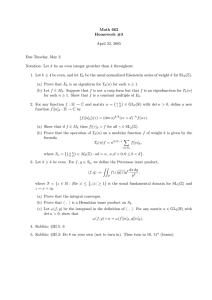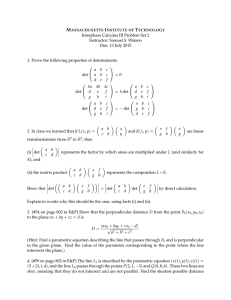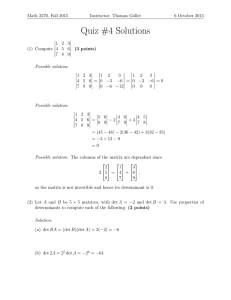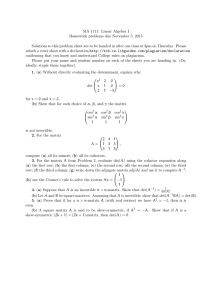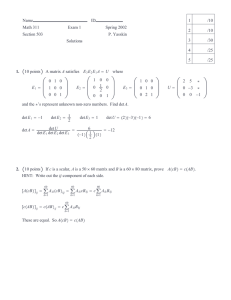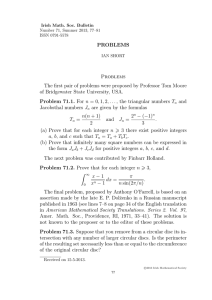AMM problems February 2014, due before 30 June TCDmath problem group
advertisement
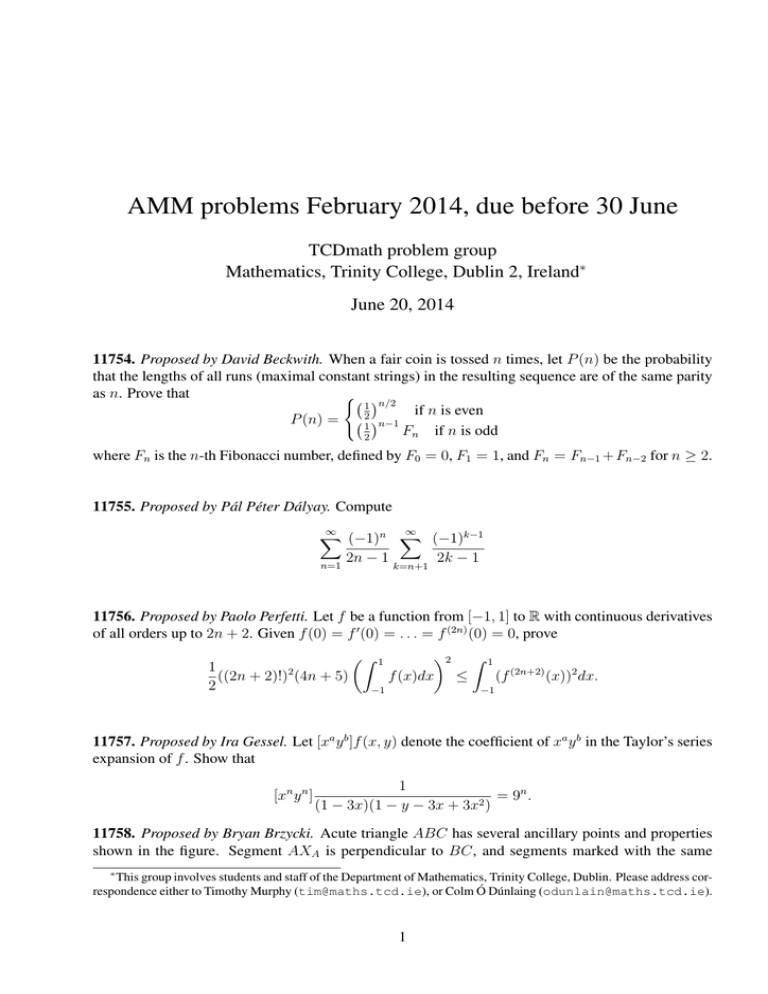
AMM problems February 2014, due before 30 June TCDmath problem group Mathematics, Trinity College, Dublin 2, Ireland∗ June 20, 2014 11754. Proposed by David Beckwith. When a fair coin is tossed n times, let P (n) be the probability that the lengths of all runs (maximal constant strings) in the resulting sequence are of the same parity as n. Prove that ( n/2 1 if n is even 2 P (n) = n−1 1 Fn if n is odd 2 where Fn is the n-th Fibonacci number, defined by F0 = 0, F1 = 1, and Fn = Fn−1 +Fn−2 for n ≥ 2. 11755. Proposed by Pál Péter Dályay. Compute ∞ ∞ X (−1)n X (−1)k−1 2n − 1 k=n+1 2k − 1 n=1 11756. Proposed by Paolo Perfetti. Let f be a function from [−1, 1] to R with continuous derivatives of all orders up to 2n + 2. Given f (0) = f ′ (0) = . . . = f (2n) (0) = 0, prove 1 ((2n + 2)!)2 (4n + 5) 2 Z 1 f (x)dx −1 2 ≤ Z 1 (f (2n+2) (x))2 dx. −1 11757. Proposed by Ira Gessel. Let [xa y b ]f (x, y) denote the coefficient of xa y b in the Taylor’s series expansion of f . Show that [xn y n ] 1 = 9n . (1 − 3x)(1 − y − 3x + 3x2 ) 11758. Proposed by Bryan Brzycki. Acute triangle ABC has several ancillary points and properties shown in the figure. Segment AXA is perpendicular to BC, and segments marked with the same ∗ This group involves students and staff of the Department of Mathematics, Trinity College, Dublin. Please address correspondence either to Timothy Murphy (tim@maths.tcd.ie), or Colm Ó Dúnlaing (odunlain@maths.tcd.ie). 1 symbol have the same length. The angle at C is less than the angle at B, and lines P N and RM are parallel and perpendicular, respectively, to BC. A XB R O P M B X A Y N B Q Y A C (a) Prove that |RO|/|OM | = 2. (b) Prove that P Q is not parallel to BC. (c) Letting D be the intersection of P Q and BC, show that if AD is perpendicular to BXB , then P, R, N, and M lie on a common circle. (d) For fixed B and C, describe the set of A such that AD is perpendicular to BXB . 11759. Proposed by Octavian Ganea and Cezar Lupu. Let A be an n × n skew-symmetric real matrix. Show that for positive real numbers x1 , . . . , xk with k ≥ 2, det(A + x1 I) · · · det(A + xk I) ≥ (det(A + (x1 · · · xk )1/k I))k . In addition, show that if also all xi lie on the same side of 1, then det(A + I)k−1 det(A + x1 · · · xk I) ≥ det(A + x1 I) · · · det(A + xk I). 11760. Proposed by Stefano Siboni. Let D be the closure of a simply connected, bounded open subset of R2 . Let W be the subset of [0, 1]n consisting of all points (w1 , . . . , wn ) such that w1 +. . .+wn = 1. Let g be a point in D, and let n be an integer, n > 1. With p = (p1 , . . . , pn ) ∈ Dn , let M be the function from Dn × W to R given by M (p, w) = n X wk kpk − gk2 , k=1 where k · k is the Euclidean norm on R2 . (a) Show that if M (p, w) is maximised at (p′ , w′ ), then all entries of p′ lie on the boundary of D. (b) Restricting now to the case in which n = 2 and the boundary of D is an ellipse, let (p′1 , p′2 )(w1′ , w2′ )) be a point at which M ((p1 , p2 ), (w1 , w2 )) is maximized. Show that p′1 and p′2 lie opposite each other on the major axis of the ellipse. (c) Show that if D is a disk of radius r about the origin, then the maximum value of M is r2 − kgk2 . 2


